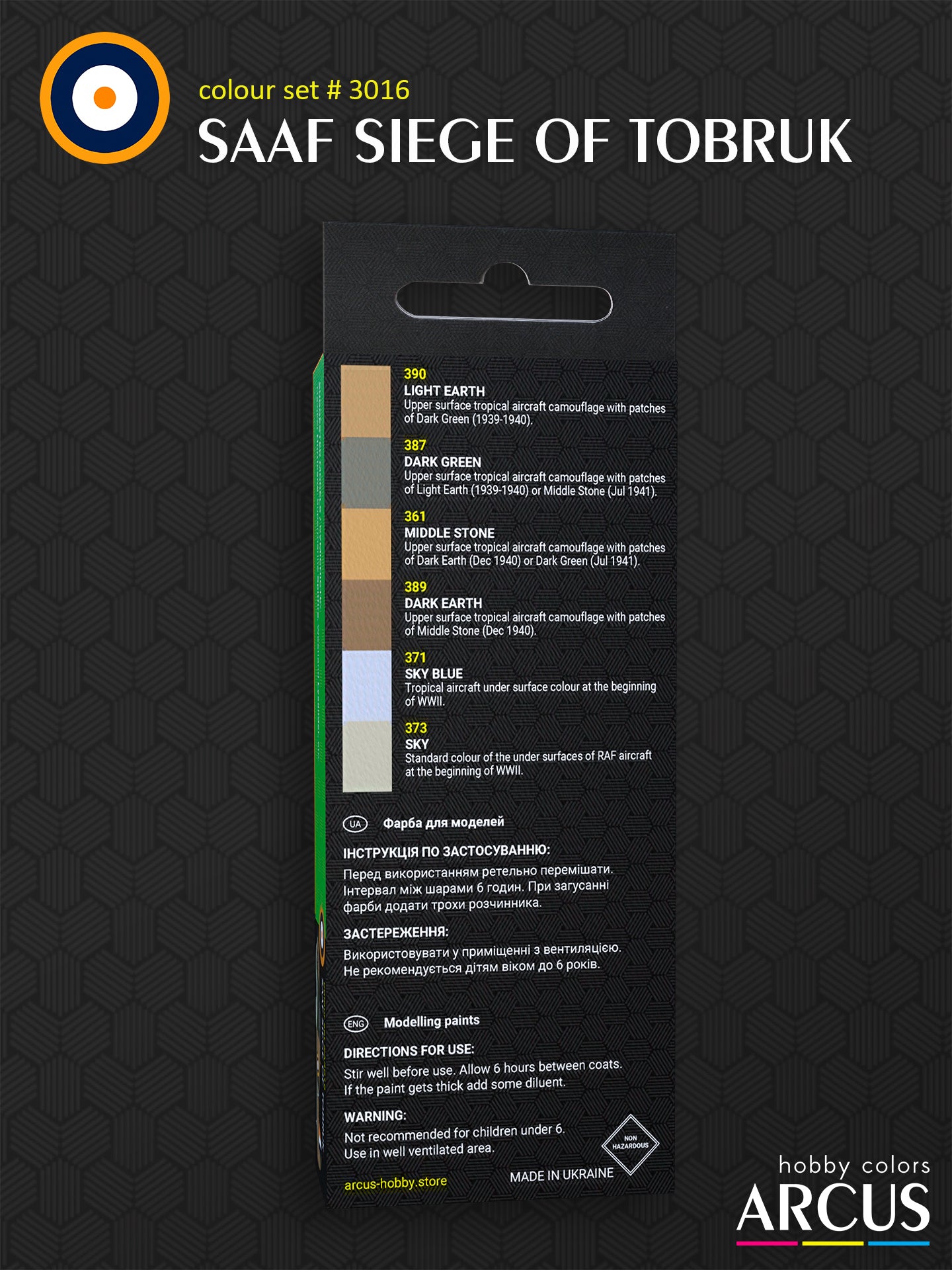Arcus Hobby
Paint Set 3016 SAAF Siege of Tobruk
Couldn't load pickup availability
SAAF Siege of Tobruk
In the tumultuous years between 1939 and 1941, the deserts of North Africa and the Middle East unexpectedly became theaters of conflict for the Royal Air Force (RAF) and the South African Air Force (SAAF). The expansive, arid landscapes posed unique challenges, but the strategic significance of the region could not be understated.
At the onset of war in 1939, the RAF deployed a diverse array of aircraft to the region, including the iconic Supermarine Spitfire and the reliable Hawker Hurricane. Simultaneously, the SAAF, despite its youth, played a pivotal role with aircraft such as the Gloster Gladiator and Hawker Hart.
The early clashes unfolded during the Italian invasion of Egypt in 1940, notably in the Battle of Sidi Barrani. The British, supported by the RAF and SAAF, successfully repelled the Italian forces in this crucial engagement. This marked the initiation of a series of conflicts that would profoundly influence the course of the war.
The Battle of Tobruk in 1941 emerged as a pivotal moment in this theater of war. The strategic port of Tobruk in Libya became the focal point of intense battles between Axis forces—led by the German Afrika Korps and the Italian army—and the Allies, including the British Commonwealth and the Free French. RAF and SAAF squadrons, equipped with the Supermarine Spitfire and Hawker Hurricane, played pivotal roles in providing air support during the siege of Tobruk.
The battles in the North African and Middle Eastern theaters pitted the RAF and SAAF against the Italian Regia Aeronautica, equipped with formidable aircraft such as the Fiat Cr.42 and the Macchi Mc.200. The desert skies witnessed intense aerial dogfights, reflecting the determination of both sides to secure air superiority in support of their ground forces.
As the conflict escalated, the German Luftwaffe entered the fray, introducing aircraft like the Messerschmitt Bf 109 and Junkers Ju 87 Stuka dive bombers. The Battle of Tobruk and the surrounding desert campaigns showcased the skill and resilience of RAF and SAAF pilots, among them Richard Pattle, engaged in fierce aerial combat against a formidable enemy.
Richard Pattle, a notable RAF ace during this period, played a significant role in defending the skies over North Africa and the Middle East. His skill and leadership were evident in numerous dogfights, contributing to the success of Allied air forces in the region.
Other distinguished aces, such as Neville Duke, played significant roles, contributing to the Allied success in the region.
The battles in North Africa and the Middle East from 1939 to 1941, including the Battle of Sidi Barrani and the Siege of Tobruk, served as a prelude to the broader conflicts that unfolded in subsequent years. The RAF and SAAF's performance during this period laid the groundwork for future air campaigns, underscoring the critical importance of air superiority in the challenging and often overlooked theaters of World War II.
Use Guide for the Set SAAF Siege of Tobruk
- The tropical camouflage scheme was introduced in 1939. It originally involved camouflaging the upper surfaces of the aircraft with Dark Green and Middle Stone colors, while the lower surfaces were painted Sky Blue.
- Aircraft supplied from the mainland were originally painted using the Temperate Land scheme in Dark Earth and Dark Green colors. Light Earth distemper was used to cover Dark Green for the Western Desert, or Dark Earth for aircraft operated in Greece or the Nile Delta in Egypt.
- In December 1941, according to AMO regulation A.926/40, Middle Stone was to replace Dark Green in tropical camouflage.
- In July 1941, Dark Green was erroneously restored in tropical camouflage which became Dark Green and Middle Stone. This erroneous decision was corrected in December 1941, and aircraft operating in North Africa and the Middle East were to be camouflaged in Middle Stone and Dark Earth.
- In July 1942, the Desert Scheme replaced the Tropical Scheme used for RAF aircraft operating in North Africa and the Middle East.
Set SAAF Siege of Tobruk Includes:
- 390 Light Earth - A light sandy-brown distemper paint of the upper surfaces of the aircraft.
- 387 Dark Green - A green camouflage color of the upper surfaces of the aircraft.
- 361 Middle Stone - A tropical sand camouflage color of the upper surfaces.
- 389 Dark Earth - A brown drab camouflage color of the upper surfaces.
- 371 Sky Blue- A light blue tropical color of the lower surfaces of the aircraft.
- 373 Sky - A light yellowish-gray color of the lower surfaces of RAF aircraft beginning in 1940. Some aircraft retained this color of the undersides.
Collection:
This Set is Best for:
- Bristol Blenheim
- Curtiss P-40 Tomahawk
- Gloster Gauntlet
- Gloster Gladiator
- Hawker Fury
- Hawker Hart
- Hawker Hurricane
- Supermarine Spitfire
- Westland Lysander
- Vickers Wellesley, etc.
Paint Type:
- Acrylic A3016
- Enamel E3016
Paint Finish:
- Semi-gloss
Capacity:
- 6 x 10 ml. (6 x 0.33oz)





